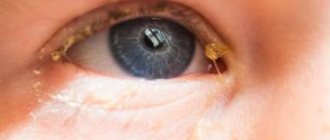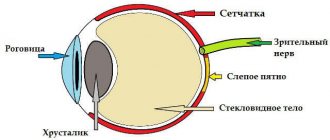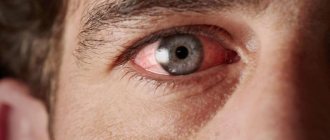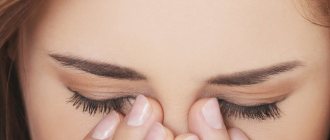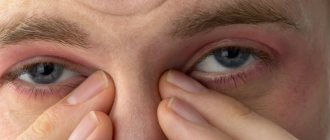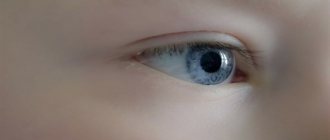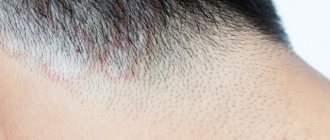Fatigue, bags under the eyes, irritation, the feeling of sand in the eyes, which reduces visual acuity, are familiar to many. In some cases, these symptoms go away after good sleep or rest, in others, eye irritation intensifies and causes physical discomfort. This interferes with seeing, reading, and doing work well.
The eyes are not only the mirror of the soul, but also an organ that quickly responds to any changes in the visual, respiratory, immune, nervous and other systems. Irritation in the corners of the eyes can occur, for example, due to conjunctivitis. Redness, irritation of the eyes, and watery eyes are often accompanied by infection of the nasolacrimal duct or lacrimal sac (dacryocystitis). Eye irritation is also often confused with the early stages of a cold. Indeed, acute respiratory infections, acute respiratory viral infections and influenza are often accompanied by irritation and redness of the eyes, and only by eliminating the cause of the disease, the infection, can you get rid of the irritation.
Possible reasons
Irritation of the mucous membrane of the eyes occurs under the influence of negative environmental factors:
- polluted or dry air;
- the presence of substances in the air that cause allergies in humans;
- prolonged exposure to bright light;
- working at a computer or watching TV, using gadgets;
- reading in poor lighting;
- working with small objects;
- lack of sleep.
Irritation can occur due to incorrectly fitted glasses or contact lenses.
Dry eye syndrome - symptoms and treatment
The causative processes that cause dry eye are usually irreversible, so treatment is based on controlling symptoms and preventing damage to the surface.
The patient needs to reconsider his lifestyle:
- do not wear contact lenses longer than the manufacturer recommends;
- stop using drugs with potentially toxic effects (drops with preservatives);
- ensure that the humidity level in the room is sufficient;
- blink more often while reading, watching TV or working at the computer;
- Position the screen so that it is below eye level.
Interestingly, when wearing a virtual reality headset, the lipid layer thickness and tear film stability are better than when using a regular desktop computer [8].
Severe eye dryness in e-cigarette smokers and vapers indicates the potential harm of e-cigarette and vaping vapors to the eyes. They degrade the quality of the tear film, causing dry eye syndrome to become moderate to severe. In addition to steam, the tear film is affected by dangerous byproducts of vaping [4].
The quality of tears is also affected by body mass index. A recent study found that tear quality was lower in people with a high body mass index than in people with a normal weight [10]. Therefore, proper nutrition can reduce the risk of developing metabolic disorders in the body, and therefore dry eye syndrome.
Surgery is the most effective means of improving visual acuity for cataracts. Although current cataract treatments are safe and effective, several complications can develop after surgery, such as cystoid macular edema, as well as dry eye. The causes of postoperative dry eye have not yet been established. Therefore, if a patient is planning laser refractive surgery, the doctor should warn him that this procedure may lead to or worsen dry eye syndrome [3].
No drugs have yet been developed for the prevention of postoperative dry eye. Although the use of nonsteroidal anti-inflammatory drugs is effective in reducing the incidence and severity of postoperative cystoid macular edema, they can cause side effects, including surface abnormalities and dry eye. Therefore, postoperative medications must be carefully selected to improve treatment outcomes and prevent the development of keratoconjunctivitis sicca [6].
Symptoms
Irritation occurs in the corners of the eyes, on the mucous membranes or on the skin. Regardless of the cause, there are common symptoms:
- redness of the mucous membrane, white of the eyes;
- increased lacrimation;
- burning sensation, foreign body behind the eyelid;
- blurred vision.
Skin irritation does not occur immediately. Due to discomfort and watery eyes, a person constantly rubs their eyes, which causes damage to the skin. The eyelids become swollen and wrinkles appear.
How to quickly relieve eye irritation
To improve the condition of your eyes and get rid of irritating symptoms, you need to find out their cause. Most often, the problem is caused by visual strain, so you need to adjust your work and rest schedule. Special drops and folk remedies help treat eye irritation.
Medications
The pharmaceutical market offers many remedies for eye irritation. Most of them are presented as drops; ointments are used less frequently:
- “Systein Balance” - moisturizes and protects the cornea from drying out;
- “Hypromellose” - restores the production of tear fluid;
- “Visine” - reduces tension, eliminates redness.
Drops are instilled from the outer corner of the eye, then lightly massage the closed eyelid. If the mucous membrane is damaged, healing gels are used - “Solcoseryl”, “Korneregel”. They are applied to the conjunctiva 10-15 minutes after the drops.
More information about anti-irritation drops can be found in the corresponding article.
Folk remedies
In addition to medications, folk remedies are used. You can relieve eye irritation at home by:
- cold compress - moisten a cloth in cold water, squeeze lightly, apply to closed eyelids for 10 minutes;
- It is more effective to make compresses from a decoction of chamomile, sage, St. John's wort;
- lotions from green tea bags;
- infusion of chamomile or mint for rinsing;
- slices of fresh cucumber applied to the eyelids;
- masks made from grated raw potatoes.
Rubbing it with ice cubes made from parsley or aloe juice helps strengthen the skin around the eyes. You can increase skin tone and eliminate redness of the conjunctiva by washing your eyes with an infusion of rose petals.
Watch a full video review of eye compresses for irritation and fatigue:
Causes of eye irritation
Red, irritated eyes may be a result of fatigue from working on a computer for long periods of time or a sign of illness. Main symptoms of the disease:
- Cutting
- Itching
- Tearing
- Swelling
- Increased sensitivity to light
- Foreign body sensation
- Dry eyes
- Overwork.
The cause of irritation may be a foreign body entering the eye, street dust, drafts, hazardous working conditions (smoky or dark rooms), as well as chemical or other substances entering the eye.
Redness can also appear due to heavy visual stress or as a symptom of a chronic or acute disease.
Pathological eye irritation
- this is a reaction of the mucous membrane of the eye to an ophthalmological (dry eye, conjunctivitis, stye on the eye, glaucoma, trachoma) and non-ophthalmological disease or pathology, for example an autoimmune disease, a cold.
Dry eyes can also be accompanied by irritation
. This is both an age-related disease and one acquired due to long, concentrated work at the monitor. Constant eye strain at the computer can cause computer vision syndrome and cause irritation of the mucous membranes of the eye.
If the cause of eye irritation is lack of sleep, fatigue, prolonged reading or working at a monitor, then the only way to solve the problem is to eliminate the provoking factor.
Irritation can occur due to incorrect selection of contact lenses, wearing them for a long time and failure to comply with the recommendations of the attending physician.
Prevention
The appearance of irritation of the organ of vision can always be prevented if you know how to influence the cause. Prevention consists of observing the following measures:
- continuous work at the computer or watching TV for no more than an hour;
- after this you need to give your eyes a rest - do gymnastics, look out the window, go out into the fresh air;
- humidify the air in the room;
- use moisturizing drops;
- avoid using low-quality cosmetics;
- purchase glasses and lenses only in specialized stores;
- Protect yourself from exposure to sunlight with tinted glasses.
Eye irritation is an unpleasant symptom that interferes with a person's daily activities. It must be eliminated with the help of medicines and folk remedies; often the symptom is difficult to treat. Compliance with prevention is important, then getting rid of discomfort will be much easier.
Leave comments on the article and share your experience. Repost on social networks, it will be useful to your friends. All the best.
Dry eye syndrome
Human tears seem to us like water in which some salts are dissolved, which give the tear fluid a specific, salty-bitter taste. However, in reality there are many more components of a tear, and a tear has a complex, ordered structure - 3 layers.
The middle, so-called aqueous layer, is really water in which microelements are dissolved, and also contains a certain amount of protein and enzymes. To moisturize the ocular surface, tears are produced by accessory glands - they continuously produce small portions of tears, which, when a person moves the eyeball or eyelids, is distributed throughout the eye. If a person cries, experiencing intense emotions, the main lacrimal glands “turn on” - they produce large volumes of tear fluid.
The outer layer of the tear film is a layer of lipids, fat-like substances produced by the meibomian glands. Its main purpose is to slow down the evaporation of the water layer of tears. In addition, the thinnest film of lipids provides additional protection for the eye from small dust particles and is involved in the process of light refraction.
The inner layer of tears (mucin) is produced by the mucous membrane of the eyeball and eyelids. Mucin makes the surface of the eye smooth and promotes uniform distribution of tears over it, retains the water and lipid layers on the ocular surface. In addition, mucin contains active substances that ensure rapid regeneration of the conjunctiva and healing of microscopic damage to it.
In old age, the skin and mucous membranes dry out, and the intensity of tear production also decreases.
This problem is especially often faced by women who, due to the natural endocrine changes that accompany menopause, decrease the level of estrogen in the body, resulting in dryness of the mucous membranes of the body, including the ocular surface (cornea and conjunctiva). In general, dryness of the mucous membranes (including the cornea and conjunctiva) is considered one of the manifestations of menopause. The situation is aggravated by taking hormonal medications, so-called hormone replacement therapy.
Medicines that many older people are forced to take can dry out the mucous membranes, including the surface of the eye.
These medications include, for example, diuretics, which are often included in medications used to treat hypertension, as well as beta blockers and antidepressants. Also, over the years, certain endocrine pathologies can develop, for example, diabetes, rheumatoid arthritis or thyroid diseases; their consequence also often becomes dry mucous membranes of the eyes.
Eye drops with preservatives, which are used for many chronic eye diseases, such as glaucoma, also contribute to changes in the composition of the tear film, causing the development of dry eye syndrome and having a toxic effect on the ocular surface.
If you experience symptoms of dry eyes, discomfort, a feeling of sand in the eyes, fatigue or redness, then for a correct diagnosis and choice of therapy you need to consult an ophthalmologist. For more information about some of the available moisturizing drops, you can take the Find out what's right for you test.
